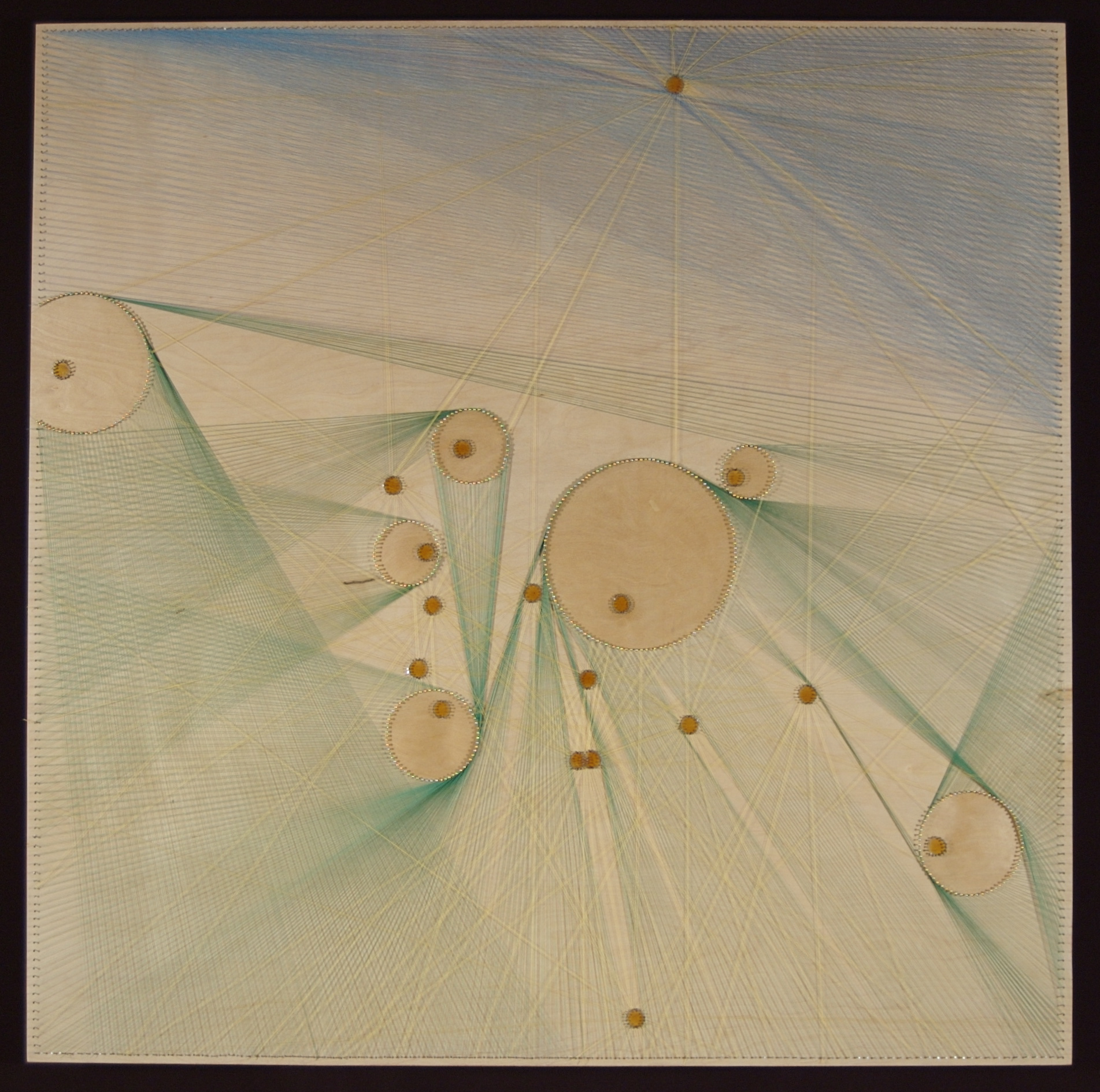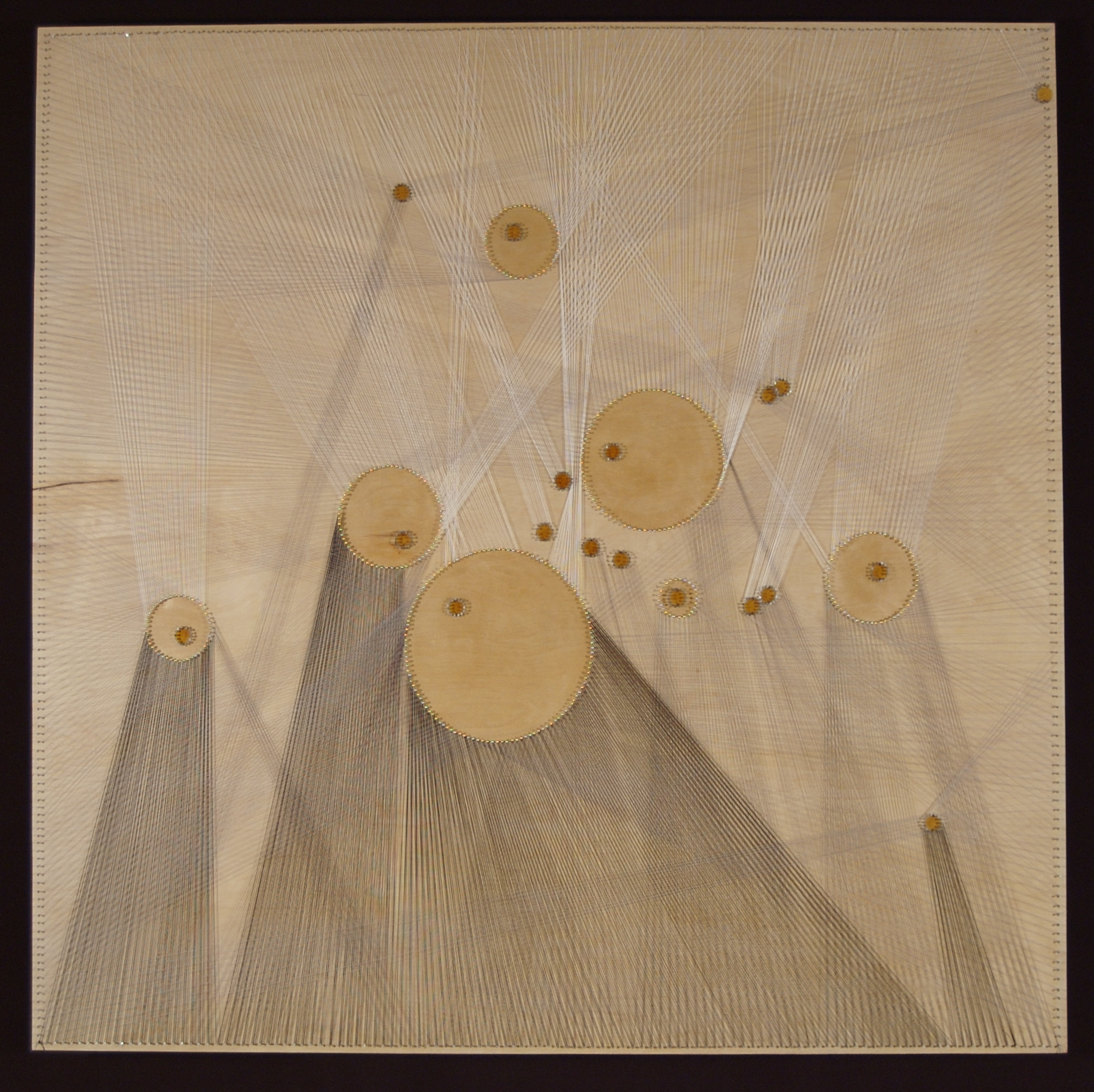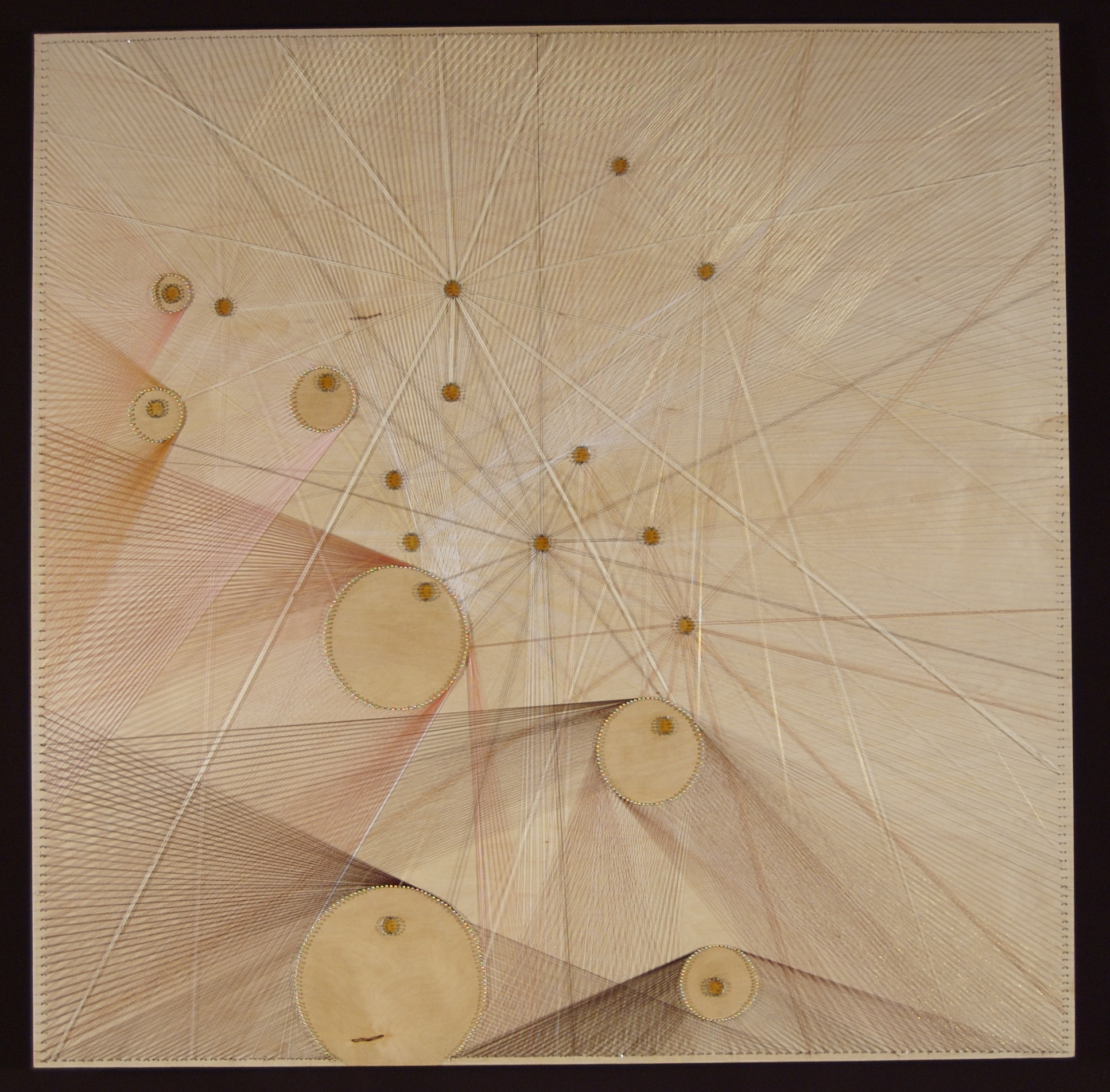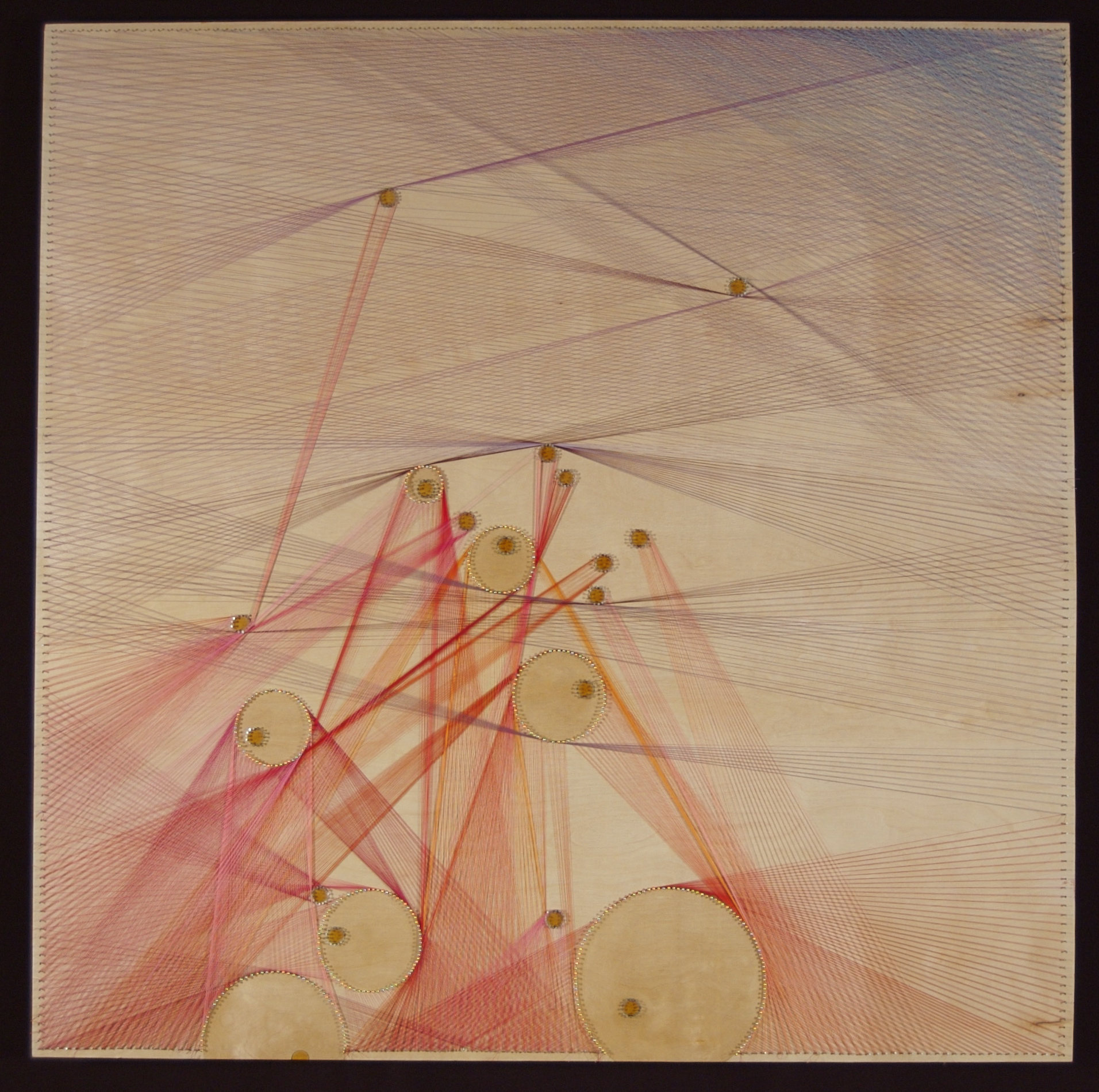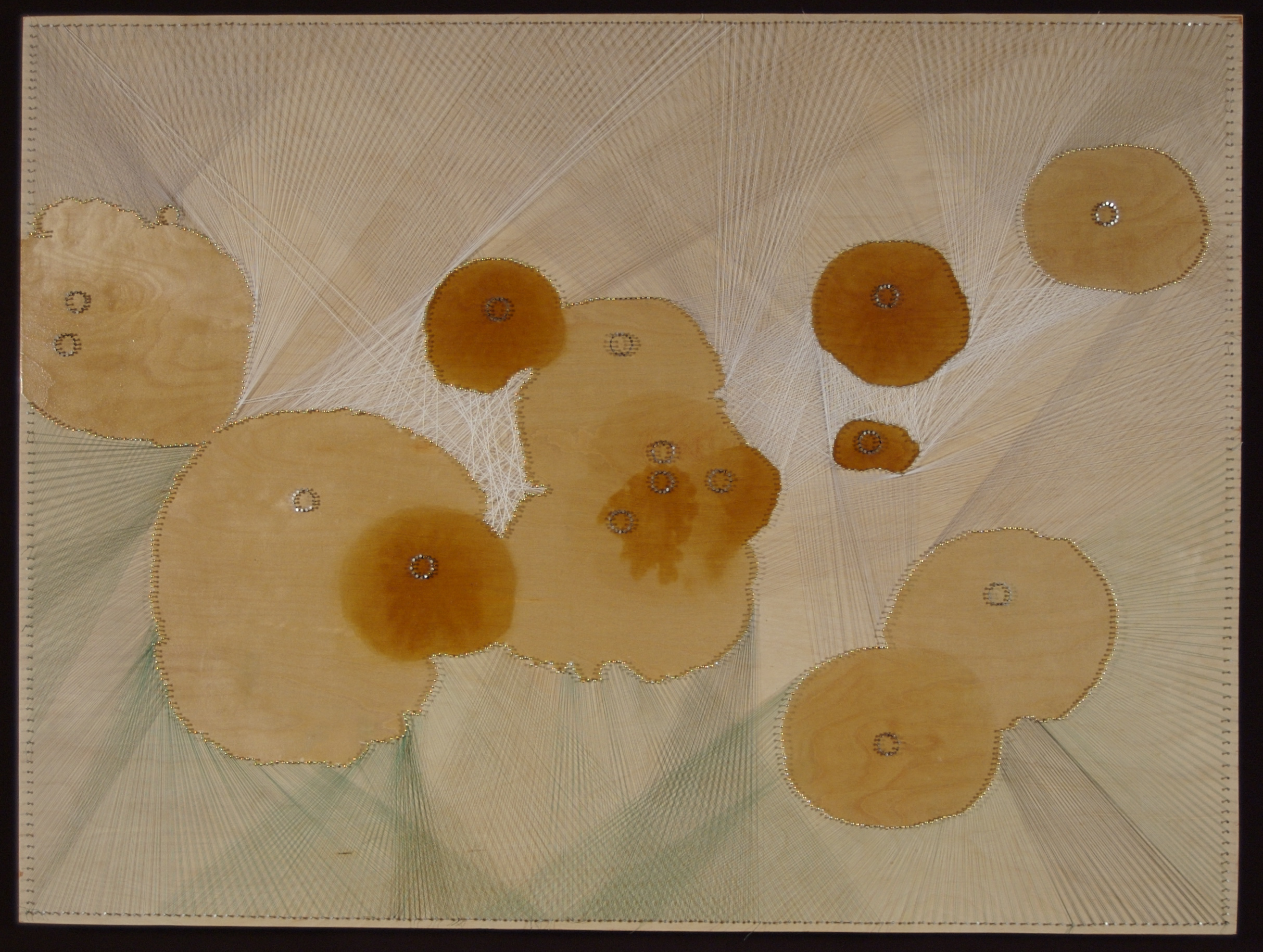Laura Jane Walker has a visionary approach to art. First, there is an event, something that negates control, like a spilled glass of milk. Freedom comes from the element of surprise, the lack of resistance to the event, the willingness to see what is present.
Then, there are the nails, the structure imposed upon the creation, a symbol for that which cannot be changed or transmuted. Static elements, the nails are the guideposts of navigation.
Between the event and the structure, thread creates a compositional element, a delicate weaving between fluidity and rigidity, understanding and the understood, what comes easily and what appears as “challenge.”
How do we navigate through life? What do we deem “good” or “bad”? How solidly do we rely upon structure? What is required to be flexible with change? And what does it take to remain open in the face of challenge? Is it courage? Perseverance? Love?
And what makes these experiences beautiful? Here’s what Laura had to say:
Many works of art represent the observer’s point of view. You mention that the thread you use represents how people respond to something: an event, happenstance, interaction with others… Do you hope that viewers see the shapes/objects within your work as fluid interrelationships between people and events?
The shape/object represent a moment in time, an event. The thread is to show a variety of ways to respond to an event and move forward. One way I see the thread is as neurons connecting one thought to another. My goal is playing with the idea that we can train ourselves to respond in healthy and intelligent ways.
How is the element of time represented (or not) in your work?
I have designed the work to show all the steps involved to create the final piece. By doing so I take materials which alone have little value—and with time, intention, and vision they turn into works of art.
How do you feel your work achieves the representation of something universal? What kinds of universal truths do you aim to represent in your work?
The representation of something universal comes from allowing the materials to do what they do organically.
As for universal truths my main message is that life is an opportunity to learn and evolve. This means every failure is a chance to gain wisdom even if it is painful.
How do you think that these works represent a kind of map that guides the viewer to destinations of universal truth? Personal truth?
The work can be a guide in the sense that I want it to challenge people. By letting go of control (and letting chance start the work) it creates the opportunity to play and respond. I want to show that mistakes can be lovely. Its a matter of sitting down with a struggle and seeing the good or acknowledging the intention of the challenge.
It’s the flaws in things that can make them extra special.
When you first begin a work, you begin with chance. Why is this so important to the work’s end result? And what greater themes of life are represented by this approach?
By giving up control and allowing things to develop organically, the piece and I are working together to make it the best it can be. I don’t want total control. It expresses the greater theme that within our own lives our control is pretty limited. Do we chose the body our soul goes to? Do we have control over the genes we are given? All I know is we have an opportunity in life to do the best with what we are given.
It’s as if these works can represent a series of maps created to help viewers bridge the gap between the world of the seen and the world of the unseen. How do these works provide guidance or teach viewers about what is beyond control? Why is this guidance/lesson important to have?
My art is meant to show that there are so many ways to respond to a given situation. Its important to look at why we respond the way we do. In my early work I was trying to say that everything is grey by only using black and white. Now that my work is slowly evolving I’m able to start breaking the rules I have made (that gave the work structure and content) which is fun, scary and really important.
How do you choose color when you work? Is this also by chance or is that part of the process strategic?
Feng Shui is a big influence on my color choices. Knowing the meaning behind the colors helps me to bring more context to the work. I’m drawn to cool and pale colors right now. Which in the Bagua map represent wisdom, self-knowledge, rest, career, life mission, creativity and individuality…that goes hand-in-hand with the where I am right now and what I’m exploring with my art work.
What do you feel size and shape represent in your work? How do the relative spaces between shapes (nails) work to provide insight into a particular idea of theme?
The work needs to be interesting from five inches away, and from fifteen feet away. This is possible by using thin thread and small nails. Up close you can see a complex matrix, but from a distance that becomes a dark spot or saturated area which lends itself to the composition.
How do your works reconcile chaos and order?
It boils down to a composition study. Spending a good deal of time looking, then adjusting, then looking some more. Eventually peace is made between the nails and thread, and between me and the final product.
There are so many layers of meaning to these works! How do these works provide a visual representation of resonance and sound? (particularly the strings)
I would like the work to conjure up the same emotions that a beautiful, sad song would. A wonderful song doesn’t tell you everything, it leaves room for your imagination to roam.
With the above notion of resonance in mind, where do we hope to find the viewer in relation to these works? As the outside observer gaining wisdom? Within the work experiencing? Both?
All I want to do is provide a window into a little world where the viewer can get lost, and hopefully come back feeling reflective.
You’ve referred to your work as a kind of Rorschach print, in which one could spend some time in contemplation. Do you find that meaning of the work emerges only after you have created these pieces? Or do you find that layers of meaning are revealed during the process of creation? What is the experience like for you?
My intention is to challenge myself and to make something someone would love to have in their life.
That being said, the story of the piece changes as it evolves. The challenges and solutions within a piece alter the way I feel about it. A good one is one that fall in love with and see nothing but potential, then I hate it, then I keep looking and changing it until I fall back in love.

Laura Jane Walker was born in Gold Beach, Oregon. She and her family
lived in Oregon and New Mexico throughout her childhood, and eventually
settled in the Pacific Northwest. In 2011, Laura received her
bachelor of fine arts (with a focus on sculpture) from the Pacific
Northwest College of Art. Since graduating, she has had numerous solo exhibitions and contributed to many group shows, including Vermont Institute of Contemporary Art. Currently, Laura’s artwork is exhibited throughout the Southwest. Laura resides and works in southern Vermont. She is represented by Beals & Co., Santa Fe, New Mexico.

